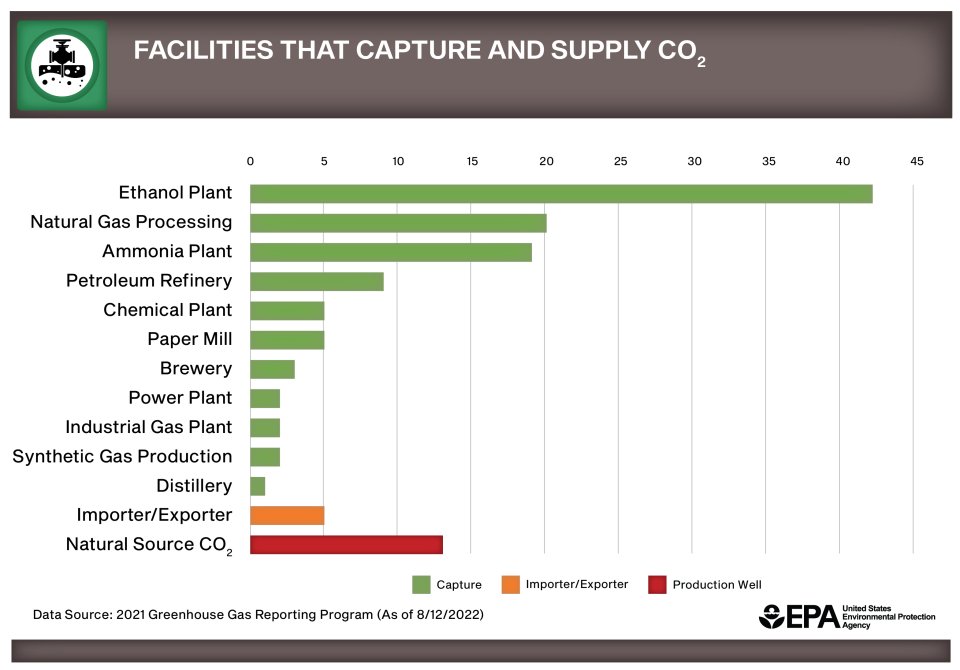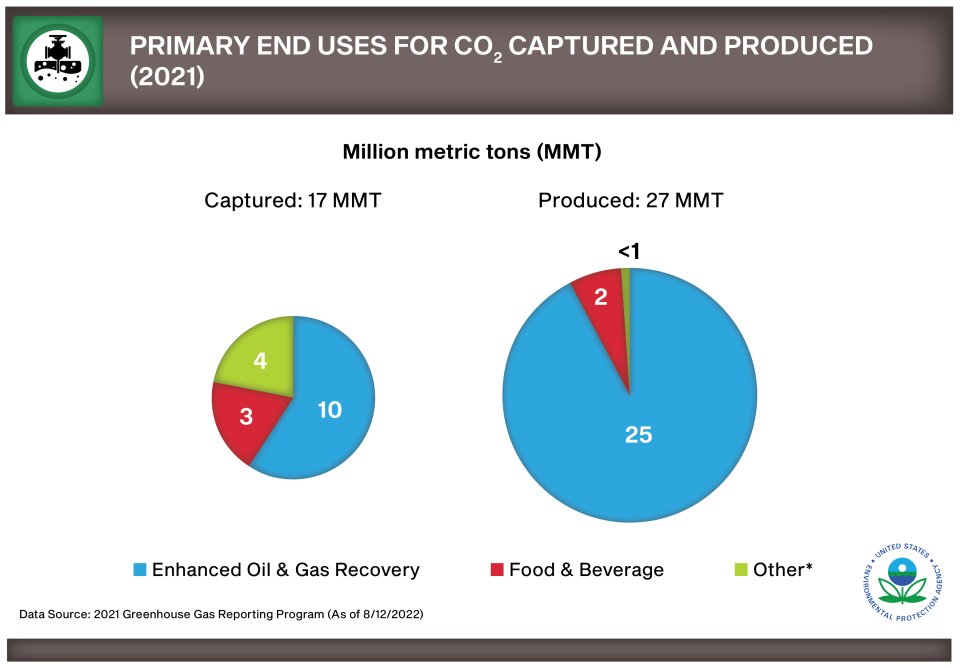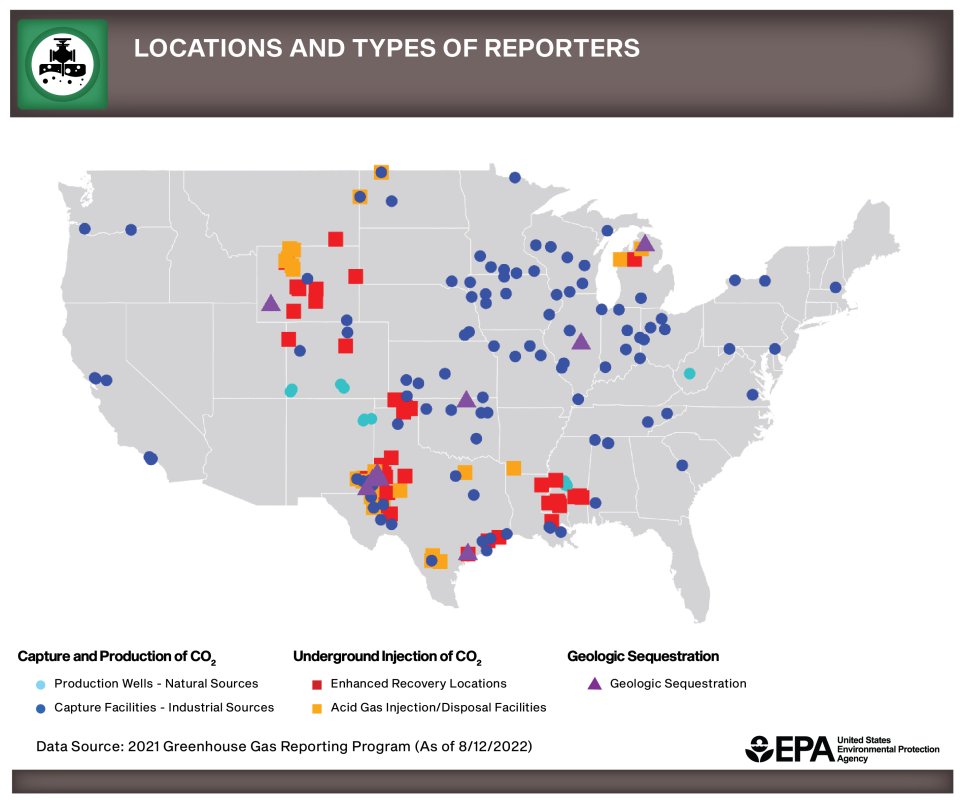GHGRP 2021: Supply, Underground Injection, and Geologic Sequestration of Carbon Dioxide
•Emissions Trends •Emissions by GHG •Emissions by Location •Emissions Ranges
Sector Data Highlights
•Chemicals (Non-Fluorinated Chemicals) (Fluorinated Chemicals) •Electrical Equipment •Electronics Manufacturing •Metals •Minerals •Miscellaneous Combustion •Petroleum and Natural Gas Systems (Onshore Production) (Other Industry Segments) •Power Plants •Pulp & Paper •Refineries •Underground Coal Mines •Waste •Suppliers •Natural Gas and Natural Gas Liquids •Petroleum Products •Industrial GHGs & Products Containing GHGs •Supply, Underground Injection, and Geologic Sequestration of CO2 •Fluorinated GHG Emissions and Supplies
EPA's Greenhouse Gas Reporting Program (GHGRP) collects key information regarding the supply, underground injection, and geologic sequestration of carbon dioxide (CO2) in the United States. Greenhouse gas (GHG) data from these activities are reported under the following GHGRP subparts:
- Suppliers of CO2 (subpart PP) covers facilities that capture CO2 from industrial sources and processes or extract it from natural CO2-bearing formations for supply into the economy.
- Underground injection of CO2 (subpart UU) covers facilities not reporting under subpart RR that inject CO2 underground for the enhanced recovery of oil and natural gas, acid gas injection/disposal, carbon storage research and development (R&D), or for any other purpose other than geologic sequestration.
- Geologic sequestration of CO2 (subpart RR) provides a mechanism for facilities to monitor and report to EPA amounts of CO2 sequestered. Facilities must submit and receive approval for a monitoring, reporting and verification plan (MRV plan) before they can report data under subpart RR. EPA MRV plan decisions can be found on the subpart RR page. Once the plan is approved, facilities report basic information on CO2 received for injection, data related to the amounts of CO2 sequestered, and annual monitoring activities. Note that any subpart RR decision pertains only to subpart RR, and does not in any way replace, remove, or affect Underground Injection Control (UIC) permitting obligations.
| GHGRP, 2021a | Reporting Facilities |
|---|---|
| Supply of CO2 (Subpart PP)b | |
| Number of suppliers of CO2 captured (industrial sources) | 110 |
| Number of suppliers of CO2 produced (natural sources) | 13 |
| Underground Injection of CO2 (Subpart UU) | |
| Number of facilities reporting CO2 received for enhanced oil and gas recoveryc | 59 |
| Number of facilities reporting CO2 received for acid gas injection/disposal, and other purposes | 28 |
| Geologic Sequestration of CO2 (Subpart RR) | |
| Number of facilities reporting geologic sequestration of CO2 | 9 |
| a As of August 12, 2022 b The GHGRP also collects data from importers and exporters of carbon dioxide. These data are not provided in the table but these reporters can be identified through FLIGHT. c Does not include facilities that conduct enhanced oil and gas recovery and that also report geologic sequestration of CO2 under Subpart RR. |
|
| GHGRP, 2021a | Amount (MMT)b |
|---|---|
| Supply of CO2c (Subpart PP) | 44.0 |
| CO2 captured (industrial sources) | 16.9 |
| CO2 produced (natural sources) | 27.1 |
| Primary End Uses of Captured and Produced CO2 (Subpart PP) | |
| Enhanced oil and gas recovery | 35.1 |
| Food and Beverage | 5.0 |
| Otherd | 3.9 |
| Geologic Sequestration of CO2 (Subpart RR) | |
| CO2 sequestered in the reporting year (2021) | 6.9 |
| a As of August 12, 2022 b Million Metric Tons c The GHGRP also collects data from importers and exporters of carbon dioxide. These data are not provided in the table but these reporters can be identified through FLIGHT. d Includes cleaning and solvent use, fumigants and herbicides, transportation and storage of explosives, fire-fighting equipment, industrial and municipal water/wastewater treatment, pulp and paper, metal fabrication, greenhouse plant growth, geologic sequestration, and unknown (which may include enhanced oil and gas recovery). |
|
| GHGRP, Cumulative Over All Reporting Yearsa | Amount (MMT)b |
|---|---|
| Geologic Sequestration of CO2 | |
| Geologic Sequestration of CO2 (cumulative CO2 sequestered by all subpart RR facilities over all reporting years of GHGRP | 38.8 |
| a As of August 12, 2022 b Million Metric Tons |
|
Capture and Supply of CO2
Ethanol, natural gas, and ammonia production are among the top three industrial facility types that capture CO2 for supply into the economy.

In 20211, most of the CO2 captured from industrial processes (59 percent) and nearly all of the CO2 produced from natural sources (92 percent) was used for enhanced oil and gas recovery. Food and beverage manufacturing is the second most common end use, followed by other end uses such as pulp and paper manufacturing, fire-fighting equipment, and metal fabrication.
1 As of 8/12/2022.

Totals may not sum due to independent rounding.
* Includes cleaning and solvent use, fumigants and herbicides, transportation and storage of explosives, fire-fighting equipment, industrial and municipal water/wastewater treatment, pulp and paper, metal fabrication, greenhouse plant growth, geologic sequestration, and unknown (which may include enhanced oil and gas recovery).
Note that some CO2 suppliers reported the primary end use for captured or produced CO2 as "unknown." It is believed that the quantities reported by CO2 suppliers as "unknown" account for the difference between CO2 received for enhanced oil and gas recovery and CO2 supplied for enhanced oil and gas recovery.
Underground Injection of CO2
After CO2 is captured or produced, it can be compressed and transported to a site where it is injected underground. Some facilities both capture or produce CO2 and inject it underground onsite.
The primary use of carbon dioxide is for enhanced oil and gas recovery. Enhanced oil and gas recovery helps to mobilize oil and gas in underground hydrocarbon reservoirs, thereby increasing production. While most CO2 captured or produced is supplied to facilities that conduct enhanced oil and gas recovery, a smaller portion is injected underground for other purposes.
Geologic Sequestration of CO2
After capture, CO2 is compressed and then transported to a site where it is injected underground for permanent storage (also known as “geologic sequestration”). CO2 is commonly transported by pipeline, but it can also be transported by train, truck, or ship. Geologic formations suitable for sequestration include depleted oil and gas reservoirs, deep saline formations, and unmineable coal seams.

